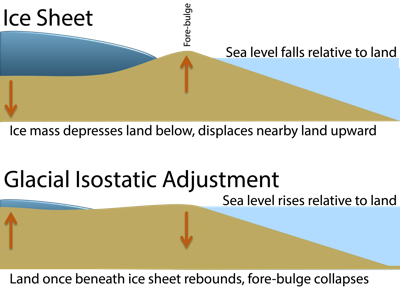U.S. West Coast
Sea-Level Trends & Processes
Trend Values for 2024
Processes
In addition to steric changes, the dominant processes affecting sea-level rise along the U.S. West Coast are glacial isostatic adjustment, tectonic processes, and ocean dynamics. Because the magnitude of these processes varies along the coast, tide stations here experience sharply different rates of sea-level change.
Learn more by expanding the dropdowns and visiting our Processes page.
Glacial Isostatic Adjustment (GIA)
|
Water Storage/WithdrawalPoland (1960) identified land subsidence due to groundwater withdrawal throughout large areas of central California in the 1950s. However, only two near-coast areas were specifically identified: Santa Clara (near San Francisco and Alameda) and Wilmington (near Los Angeles). It is unclear how groundwater withdrawal near these locations might have affected the magnitude of land subsidence at the nearby tide-gauge stations (if at all), or how that effect may have changed over time. |
Ice Sheet Melting (Greenland and Antarctica)Global modeling by Mitrovica et al. (2001) suggests that melting of the Antarctic Ice Sheet should contribute an equal amount to sea-level rise at all West Coast stations. The same analysis suggests that contributions from the melting of the Greenland Ice Sheet and mountain glaciers will vary along the West Coast, with greater values at California stations, lesser values in Alaska, and intermediate values in Oregon and Washington. |
Ocean-Atmosphere DynamicsA shift in wind patterns along the U.S. West coast occurred during the mid-1970s, resulting in a regime shift from cold to warm phases of the Pacific Decadal Oscillation (PDO). Bromirski et al. (2011) suggest that these winds have been dynamically suppressing sea-level rise along the West Coast since the 1980s. A reversal in this trend would result in acceleration in the rate of sea-level rise. |
Other FactorsTectonic effects (post-earthquake deformation) contribute to terrestrial uplift (and thus relative sea-level fall) in parts of Alaska; the magnitude of these effects vary in time and space. Sato et al. (2012) suggest that tectonic deformation in southeastern Alaska has less impact on relative sea-level fall than deformation induced by glacial isostatic adjustment. The tectonic block on which Yakutat sits is colliding with southern Alaska, causing deformation, terrestrial uplift, and thus relative sea-level fall (Elliot et al. 2010). It is unclear how far the effects of this collision reach along the coastline. |


 Modeling by
Modeling by